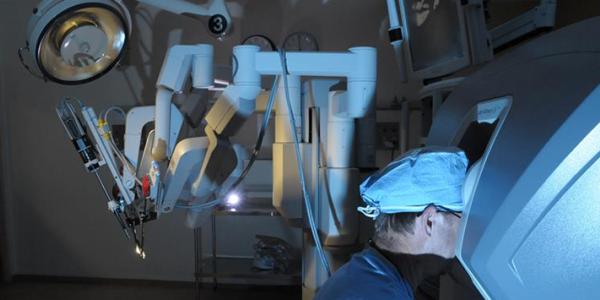


At El Camino Health, it’s only natural that we bring that technology to healthcare — robotic-assisted surgery is one way we do so. This minimally invasive approach allows surgeons to perform complex procedures through tiny incisions with greater accuracy. This makes all the difference for patients. Smaller incisions mean a safer surgery, less pain and scarring, and a quicker recovery. And, procedures often take significantly less time than other approaches and less time in the hospital — sometimes without a hospital stay.
We embrace this technology because it improves care for patients.
Using a console in the operating room, the surgeon manipulates surgical instruments attached to robotic arms. This allows them to make precise movements with the stability and dexterity beyond what’s possible with the human hand.
Advanced equipment such as 3D imaging lets them see a magnified view of the surgical area on a screen, giving surgeons a variety of tools that let them operate with greater confidence, efficiency and precision.
Our skilled surgeons perform the most robotic-assisted surgeries in the region — more than 11,000 procedures. Surgery volume is important for patients — the higher the volume, the greater the expertise. Patients come to El Camino Health with the confidence that they’re in the capable hands of experts.
We’ve come a long way from first using robotic-assisted surgery in 2006 with one type of system — today, we use four. More than 50 surgeons across a range of specialties — including weight loss, digestive health, gynecology, cancer care, orthopedics, spine and pulmonary care — are certified to use them.
We use the da Vinci, our first robotic system, to treat bladder and pelvic conditions, cardiothoracic conditions, prostate and gynecologic cancers, hernias, and conditions that affect the colon and pancreas. Our surgeons also use it for weight-loss surgeries — one of only two hospitals in the San Jose area that are a center of excellence for this procedure. They can use it to treat prostate cancer using just five small incisions. And, the system’s Single-Site™ instrumentation allows surgeons to remove the gallbladder, without visible scarring, through a single incision in the navel.
As an early adopter in the region, our experience prompted other hospitals to send their surgeons to us for training — a testament to our expertise.
Our interventional pulmonologists use Ion™ Endoluminal System to take samples (biopsies) of hard-to-reach lung nodules, without surgery. Following an investigative study, El Camino Health was the first in the world to perform the procedure and has done more than 50 procedures since then. It uses a small, flexible tube (catheter) inserted through your mouth. The doctor guides a needle through the tube to get the sample.
Robotic bronchoscopy allows doctors to take tissue samples from a few areas of the nodule, which helps ensure a correct diagnosis. It’s more accurate than a conventional needle biopsy and helps prevent the need for repeat biopsies. This procedure lets doctors catch lung cancer early, when it’s most treatable.
Our orthopedic surgeons use the Mako Robotic-Arm Assisted Joint Replacement for total knee and hip replacements and partial knee replacements, which are used to treat joint pain caused by arthritis.
The Mako system combines still images taken before surgery with moving images taken during the procedure to show surgeons how the joint moves. Surgeons can predict how the new joint will affect the tendons and ligaments around the joint and customize the surgery to offer patients the best results. This means surgeons can align the joint more accurately, which results in a more natural-moving joint.
The Mazor X Stealth™ Edition Robotic Guidance Platform lets surgeons plan and perform spine surgery more accurately. They can create a 3D simulation of the spine before the procedure so that they can develop a predictable, effective surgical plan based on each person's spine.
During the procedure, the technology’s 3D imaging shows a magnified view of the spine and the exact placement of surgical instruments or spine implants. The robotic arm holds surgical instruments in place, and the technology guides the surgeon to perform the surgery exactly as planned.
For more than a decade, we've been a leader in robotic-assisted surgery and continually adopt the latest, most promising technologies — this won’t ever change. It’s how we fulfill our commitment to providing the highest quality of advanced medicine and personalized care. Find out more about robotic-assisted surgeries at El Camino Health.
El Camino Health provides a personalized healthcare experience at two nonprofit acute care hospitals and primary care, multi-specialty care, and urgent care locations across Santa Clara County. Bringing together the best in technology and advanced medicine, the network of physicians and care teams deliver high-quality, compassionate care.

Identify your risk factors and what to do if you are at risk.